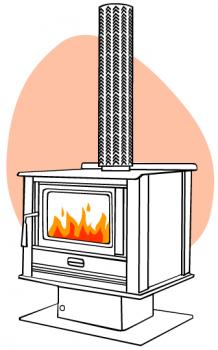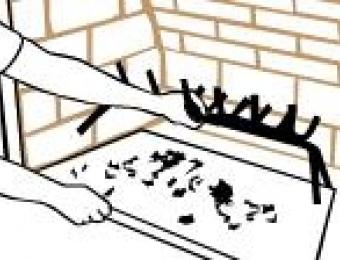
Wood heaters are heaters that burn solid fuels to produce heat. Wood is by far the most commonly used fuel. Coal, peat and organic pellets have greatly declined in use. Wood heaters rely on either radiant heat, convective heat, or a combination of both to warm the home, and do so with varying degrees of efficiency.
Types of wood heaters and fireplaces
'Fireplace' and 'wood heater' are terms with quite diffferent meanings. A fireplace is a generally a part of the house's structure, inserted into a wall or chimney breast; a wood heater is a standalone appliance with a flue - it can also be installed into an existing fireplace.
Other solid fuel heaters include furnaces and boilers. They are often used in conjunction with hydronic systems for central heating, but other types of solid fuel heaters can also provide enough heat for the whole home too - especially when used in conjunction with ceiling fans or heat shifters.
Wood heaters are most commonly used for space heating purposes, to heat a large room or living area.
Below is a list of the types of wood heaters and fireplaces most commonly used in Australia:
- Fireplaces
- Fireplace inserts
- Slow combustion heaters
- Central heating boilers and furnaces
Different types of wood heaters and fireplaces
Fireplaces
Brick-chimney fireplaces are the most traditional wood burners, but are also the least efficient, with only about 5-10% of the energy used going towards heating the room. They produce radiant heat, and only provide heat in a localised area. Fireplaces can be expensive to install due to the added cost of installing a chimney and damper. In homes with a brick chimney, a fireplace insert is almost always a better option.
Fireplace inserts
These inserts are an effective way to improve the efficiency of an existing fireplace. They are metal inserts that fit into existing brick fireplaces, which allow the circulation of air around the metal insert and back into the room. Fireplace inserts heat using both radiant heat from the fire, and convective heat from the air that circulates around them. They offer an efficiency of around 23-25%, but they also require the installation of a flue.
Slow combustion heaters (often just called 'wood heaters')
These wood heaters are very popular, and are the ones that we most often refer to simply as actual 'wood heaters'. They work by carefully controlling the amount of oxygen available to a fire and emit heat both by radiating it out from the metal body and flue, and by convection heat through hot air released from specially designed vents. These types of wood heaters are the most efficient variety, converting between 55-70% of the energy used into to household heat when properly banked and burning slowly. Slow combustion heaters emit a lot of heat, and are very effective for heating large areas for extended periods of time.
Furnaces and boilers
These are typically large units used for centrally heating a home. Furnaces heat air, and boilers heat water. They use networks of vents or pipes to distribute heat around the home using radiators, vents and under-floor coils, and may be designed in such a way as to also provide hot water for the home. These units are generally fairly efficient, with a range between 45-70% efficiency.
How to choose a wood heater
Wood heaters that are sold in Australia need to comply with the Australian/New Zealand Standard 4013, and bear a current Certificate of Compliance.
When choosing a wood heater, you should check the back of the heater to see if it displays a compliance plate. This plate will provide you with information on the testing of the unit to the Standards, kW output and efficiency, as well as the manufacturers details.
It's a good idea to consult the retailer about the size and nature of the area you intend to heat with it - sometimes the biggest heater isn't the best option.
Installation requirements
The use of open flame heaters in a home is tightly regulated, and requires compliance with a lot of Standards to ensure your safety and the safety of your neighbours. For example, every wood heater made since 1992 must comply with AS/NZS 4013 to ensure smoke emissions are within a reasonable and safe limit.
Chimneys and flues must clear your roofline by a minimum of 600mm, and it must be at least one metre taller than any neighbours within 15 metres of your property. The flue/chimney must also be appropriate for the size of the fire heater, and must be tightly sealed to minimise excess smoke escaping back into your home.
Where do I put it?
You can essentially put a wood heater anywhere you like in a home, as long as it’s easily reachable. For this reason it can actually become part of your interior design, keeping in mind that you will also have to account for an interior flue. Wood heaters are most commonly used in living areas.
Cowls and dampers
Having a permanent opening into your home, particularly a warmish one on your roof, can attract birds, possums and other curious animals. A flue cowl is a small 'hat' on the top of the flue that helps to stop animals, birds and rainwater from coming into your home. If you have a wood heater and regularly find birds flapping around in it, investing in a cowl may be a good idea.
Dampers are used to control the flow of air out of a flue. They are generally kept closed when the heater's not in use to prevent unnecessary heat loss, and only really fully opened when the fire is first being lit to encourage the fire to start.
Cleaning and maintenance
Because of the nature of the fuel type, wood heaters of all varieties require periodic care and attention. Flues and chimneys need to be cleaned at least once a year, to help prevent the build-up of creosote. Creosote is a substance that builds up over time when wet wood or unseasoned wood is used. In extreme cases, creosote can completely clog a chimney in a matter of days, but chimneys can also be blocked by birds' nests.
Depending on the type of wood heater, you will also need to remove ash and charcoal fairly regularly.
|
Advantages
|
Disadvantages
|





